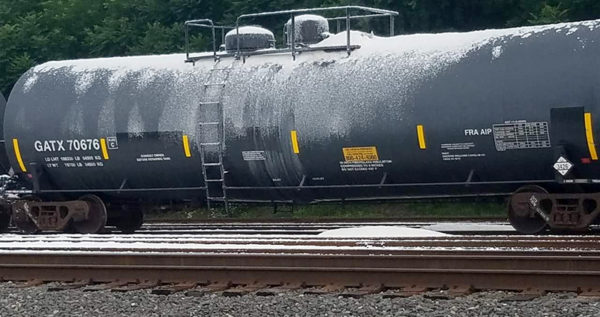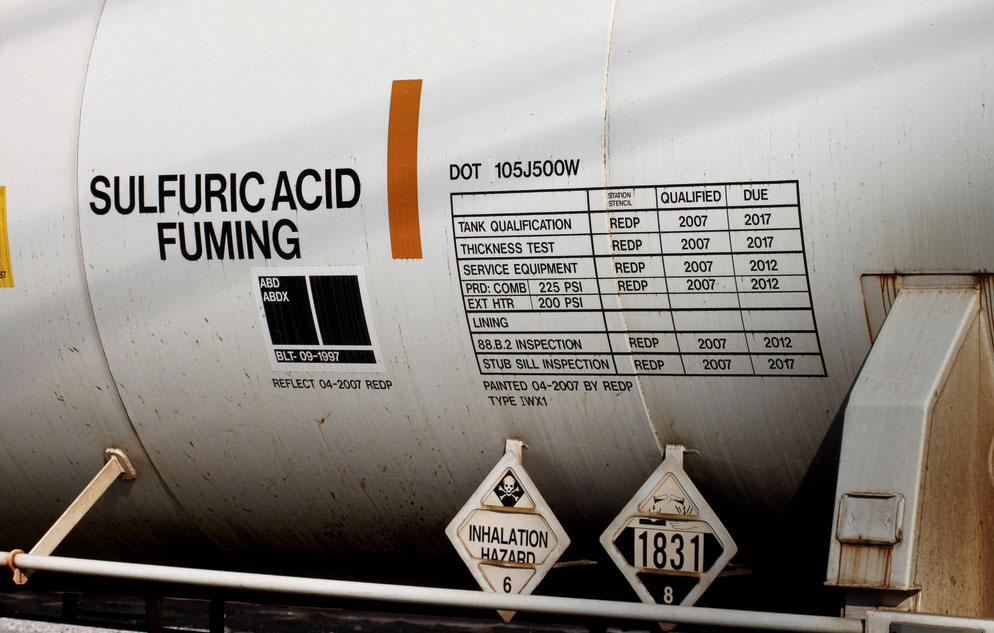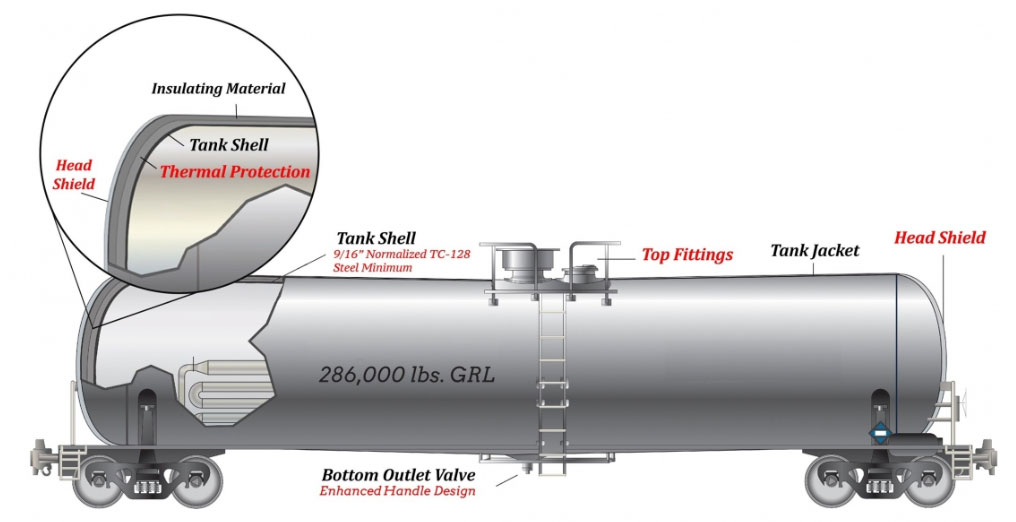Best practices and guidelines to aid plant personnel in eliminating non-accident releases.
Following these guidelines for properly securing tank cars, shippers, and receivers of hazardous materials can help reduce NARs (Non-Accident Releases). This information is based on the BOE pamphlet 34 on best industry practices. This article will cover the recommended methods for safely loading and unloading non-pressure, general service, and pressure tank cars.
Because of improved equipment efforts on behalf of Government Regulators, Shippers, and Rail Carriers, more than 99.997% of hazardous materials are safely loaded, shipped, transported, and unloaded. However, sometimes hazardous leaks do occur during normal transportation.
These leaks are called NARs, or Non-Accident Releases. One small leak could end up causing significant repercussions.
NARs (Non-Accident Releases) are hazardous leaks that occur during normal transportation.

Although only a small amount of product may be released in a NAR, the consequences can be serious.
- A NAR can expose industry employees to hazardous materials, causing injury.
- A shipment may be delayed while securing a car.
- Local communities may have to expend their limited resources in order to respond.
- Some rail yards may be shut down.
- Shippers may be fined.
- The product may be contaminated.
Fortunately, most NARs are small, and the quantity released is generally very limited. However, most NARs can be prevented altogether by using the proper loading/unloading and maintenance procedures. Employee education is also very important. To transport hazardous materials safely, everyone involved must cooperate and collaborate. Safely handling hazardous materials depends on proper preparation and correct handling to get the product to its destination without incident.
The article will be divided into three sections: 1) Recommendations for all tank cars, 2) General service tank cars, and 3) Pressure tank cars.
Recommendations for all tank cars
Before loading or unloading, do the following to ensure safe operations:
- Put a caution sign (“blue flag”) into place. Put a blue flag in either direction the car can be approached from.
- Lock the switch and/or door locking to prevent entry into the track.
- Always check the hand brakes and ensure they have been applied. Do not assume someone else has.
- Chock wheels in both directions.
- Verify that eyewash stations, safety showers, and other safety equipment are present and operational before loading/unloading.
- Ensure that the proper tools are used for load/unloading operations. They must be clean and in working condition at all times.
If a tank car contains flammable or combustible gases/liquids, it should be electrically grounded and bonded while loading or unloading. Check the continuity of the ground before loading or unloading. The loading/unloading area should have adequate lighting and be free of unnecessary equipment. Before shipment, every tank car needs to be examined. A tank car cannot be offered for transportation if it contains a hazardous material (including residue) unless it is in proper condition for safe transportation.
Before loading or unloading, inspect the following:
- Examine the safety appliances, including the steps, grab irons, ladders, and platforms, to check for broken, loose, or missing elements.
- Look under the car to ensure that break rigging is not dragging or broken.
- Look at the end cap and ensure that all three bolts are secured with a tab to prevent movement.
- Inspect the trucks and couplers to ensure there are no visible defects. Note that tank cars must have double-shelf couplers.
Before loading or unloading, inspect the car for damage and the presence of a defective card. If you find either, contact the car’s owner for further instructions before loading or unloading. Examine the tank shell and heads for defects (like dents, cracks, and/or evidence of leaks). The tank car’s jacket should not be torn or have significant damage. Check all piping, valves, fittings, and gaskets for evidence of leaks or corrosion, including those not used. Look for loose or missing bolts. Examine the pressure relief device (including any frangible discs) to ensure it is present, and there are no signs of leakage.
Ensure that there is no debris in the safety valve, such as old seals. If the safety device is a combination safety valve and a ruptured disc, open the Telltale to check that the rupture disk has not failed.
Stenciling and Markings
Be certain that you check all the required markings and stenciling. They should be legible, and the qualification date marking should be current. Verify that the car is a specification tank CTC, AAR, DOT, or TC and is compatible with the product. Additionally, check the tank car linings, coatings, or materials and ensure they are compatible with the product. Some hazardous materials require special protective features like Flammable Gases (Division 2.1), which must be shipped in tank cars with heat shields and thermal protection. Some class A materials like acids must be shipped in a car with a special lining or coating. Know if your product has any special requirements, and check the stenciling to confirm the car meets those requirements.

Every tank car needs to be qualified periodically. The qualification stencil will show when the last inspection was done, what type of pressure relief device the car has, any lining or coating the car has, and when the qualification is due again.
Check the stencils before loading to ensure the tank car has not exceeded any of the due dates. Tank cars with a safety vent ruptured disc will be stenciled with the burst pressure of the rupture disc and may be stenciled as “not for flammable liquids or “not for flammable or poisonous liquids.” When examining the rupture disc, be certain it’s marked with a burst pressure rating that matches the safety vent burst pressure stencil on the tank car.
The proper shipping name must be marked on two sides in lettering at least 3.9 inches high for all commodities listed in 49 CFR section 172.330 A12. This includes all flammable gases, poison gases, and certain other high-hazard materials. Tank cars containing poison or toxic inhalation hazard material must be marked with inhalation hazard on both sides in lettering that is at least 3.9 inches high unless the words inhalation hazard appear on the placards displayed on the tank car.
The identification numbers must be displayed on tank cars on an orange panel, on a white square on-point display, or on a placard. A square on-point configuration is a white card the same size as a placard with the ID number 3.5 inches high in the center. The identification number is most commonly displayed on a placard with the ID number 3.5 inches high in the center.
The placard needs to be readily visible from the direction it faces, and it must be displayed on both sides and both ends of the rail car. It must be securely attached or placed in a holder and displayed so that the identification number reads horizontally from left to right. It should be located clear of appurtenances like ladders. The placard must also be located so that dirt and water cannot be thrown onto the display. They must be in an area that’s maintained, so that color, format, legibility, and visibility are not substantially reduced.
When Time to Load/Unload
When loading a tank car, always leave proper outage; know how much outage is required for the tank and material; use the appropriate outage chart when loading compressed gases; do not overload by weight or volume; and monitor the car to make certain nothing is leaking. Cars must be attended to by trained personnel or monitored by an approved monitoring system while loading or unloading. Do not allow the operations to stand unattended or unmonitored while connections are attached to the car.
If operations need to be discontinued for a while, be sure that all valves are closed, all connections are removed, and the car is prepared as if ready for transportation. However, operations can be discontinued by closing valves on the car and closing valves at the facility without disconnecting hoses if the car is attended to or monitored.
Before releasing the car, be sure it is not overloaded. Ensure that all fittings, including those not used, are properly closed. All caps and/or plugs need to be in place and properly tightened using the correct tool and then attached with a cable or chain to prevent misplacement. Verify that all protective covers are closed and secured and that openings are in the closed position. Check that all caps for the interior heater coil inlet/outlet pipes are placed.
Before the tank can travel, some cars require the shipper or car owner to get a one-time movement approval from the Federal Railroad Administration. Some examples include a hole in the tank car jacket or a liquid valve that was repaired and requires a bubble leak test. All defects must be corrected before shipment. Notify the railroad of defects found in safety equipment or running gear before releasing the tank car.
General Service Tank Cars
General service tank cars are used for transporting liquids or flowable solids. Most valves and fittings are visible on the top of the car. General service fittings may include: bottom outlets, internal or external heater coil systems, top valves fittings, top-operated bottom outlets, manway, and pressure relief devices, including safety valves and safety vents. The bottom outlets can be operated from the bottom or top of the tank car. Both bottom outlets must be checked to ensure they are operating properly and not leaking. A recommended practice is to remove the bottom outlet cap or plug while loading. Ensure that the outlet valve is closed and that all auxiliary valves are opened during loading.
Before removing the cap/plug, place a bucket or spill pad down to catch any spillage. Check that there is no leakage through the valve. Check that the bottom outlet cap and door plug are attached to the car by a chain or cable to prevent misplacement. Examine the condition of the gasket. Make certain there are no leaks after loading/unloading. Be sure the operating handle is securely in the closed position.
If a car is equipped with a top-operated bottom outlet, loosen the packing nut before operating the valve, then secure the packing nut when finished to prevent leakage. The operating handle must be attached by a chain or cable to prevent misplacement. Again, ensure the outlet is closed, and the operating handle has been secured before shipping. If a tank car has interior heating coils, they must be checked for leakage during loading. Leave the outlet caps off the heater pipes and watch for leakage through the pipes to test.
Once the car has been loaded, secure the heater coil caps onto the pipes to prevent a leak if the heater coil fails during transit. Do not overheat the car. Check for steam leaks from the coils. Examples of top valves and fittings include liquid valves, vapor valves, vacuum relief valves, and safety valves. Check all top valves for operation, including valves and fittings that will not be used. Examine valves for leaks through the plug where the valve attaches to the car and/or through the valve stem.
All valves need to be closed when the car is shipped. The closures should be tightened, including the ones not used at your location. Listen to vacuum relief valves for evidence that they may not close properly, as they may allow vapors to escape. Never use a vacuum relief device to relieve the tank car’s pressure. If the top valves do not have a protective cover, handles must be removed. All protective covers must be pinned in the closed position while shipping. Be certain the pin is not damaged.
Manway Gaskets
All manway gaskets must be inspected for condition, position, and compatibility with the tank car’s material. Manway gaskets should say in place while the manway is open. If they do not, they may be the incorrect size and may slip out while the manway is closed.
Failed manway gaskets are a common source of leaks during transportation. Inspect manway gasket surfaces and bolts for damage. Look for bent bolts, bad threads, and bad washers that could prevent proper closure of the manway. If there is extensive dirt or rust on a bolt, use the appropriate lubricant. Manway bolts need to be tightened in a star pattern so that the manway is evenly tightened and has a good seal.
All bolts need to be tightened with a tool when finished. When tightening the bolts of the manway, use a torque wrench to achieve uniform tightness. Ask the car owner about proper manway torquing values for the used gasket type. While unloading, remember to vent the tank car with a closed system or vent it to the atmosphere. Do not rely on the vacuum relief valve. If the tank car is equipped with a safety vent, check for a ruptured disc. While loading, remember that both sides of the disc must be checked. Before shipment, verify that closures are secure and not leaking via a pressure test or by holding the car for 24 hours and then reinspecting it.
Pressure Tank Cars
Pressure tank cars are utilized for compressed gases and certain high-hazard materials. They are visually different than general service cars as the valves and fittings are mounted on the top in a protective housing where they are not visible.
Pressure car fittings may include:
- Liquid and vapor valves
- Gauging devices
- Sample lines
- Thermometer well
- Safety and regulating valves
DOT 117 Specifications
Safety enhancements of DOT specification 117 Tank Car

- Full-height 1/2-inch thick head shield
- Tank shell thickness increased to 9/16 inch minimum TC-128 Grade B, normalized steel
- Thermal protection
- Minimum 11-gauge jacket
- Top fitting protection
- Enhanced bottom outlet handle design to prevent unintended actuation during a train accident
Begin by examining the base of the valves, the closure plugs, and the valve stem seals of each valve on the pressure car. Check for leakage. Plugs (other than quarter-inch plugs) in the same lines and gauging devices must be attached by a chain or cable to prevent misplacement. For magnetic gauging devices, examine the rod for a commodity name. If one is present, consider if it is appropriate for the material the car is carrying. Thermometer wells and magnetic gauging devices have O-rings that require inspection. If there’s an issue with either of these, the O-ring will act as the failsafe to prevent leaks.
Covers for thermometer wells and magnetic gauging devices need to be hand tightened. Overtightening with a tool will damage the o-ring. Check sample lines to ensure they’re closed, and the plugs are tight. Check for leaks at the base of the sample lines. Protective covers need to be secured in the closed position. Access ports must have covers, and they must be closed. Before shipping, verify that closures are secure and not leaking by completing a pressure test or holding the car for 24 hours before reinspecting.
Summary
Check the condition of the tank car and fittings to ensure that all fittings, including those not being used, are secure and not leaking. Close and secure all protective covers and fittings, including those not used. Check the condition of the stenciling and pay attention to the due dates and commodity stencils. Do not overload by weight or volume. Make sure the placards and markings are correct and in good condition. Always use a checklist to ensure that all components are checked and in good working order.
According to DOT regulations, if a tank car leaks during normal rail operations, it is assumed that the car was not properly prepared and inspected before release. The shipper may be liable for all costs associated with the response and cleanup of the leak and can be subject to penalties for failure to comply with the requirements.
Resources
For more information, please refer to the US Department of Transportation requirements in 49 CFR, sections 173.31 and 174.67 of the hazardous material regulations. In Canada, look at the Canadian General Standards Board 43.147 Part IV – Sections 30.14 through 30.17 as referenced in the Canadian Transport Dangerous Goods Regulations. The Association of American Railroads Manual of standards and recommended practices M – 1002 contains information on authorized valves, fittings, and maintenance requirements. For further information on the loading and unloading tank cars, read the Bureau of Explosives pamphlet 34 contained in the BOE tariff or available at the NAR website at www.nar.aar.com. Additionally, you can contact the loading and unloading specialists at SafeRack.com for more information on how to improve processes and safely load/unload products.